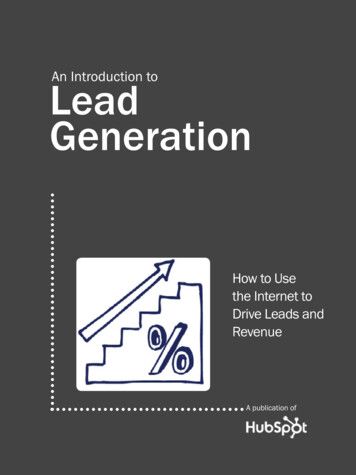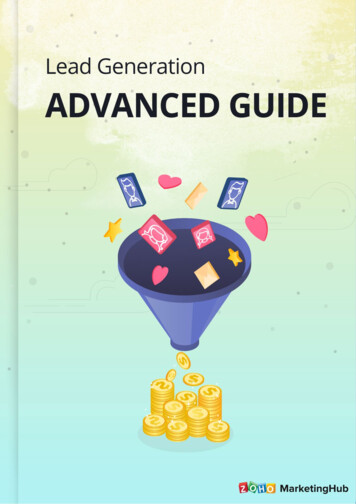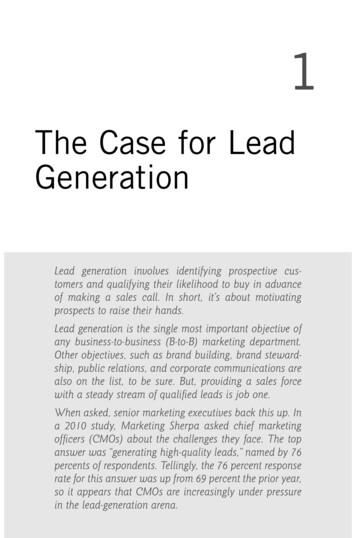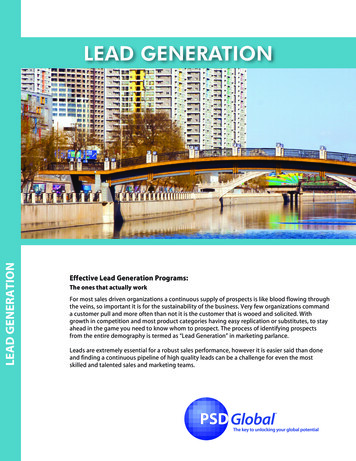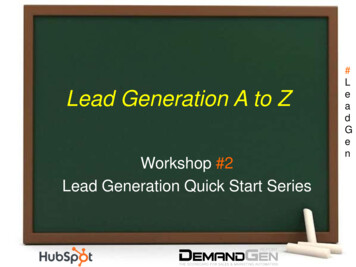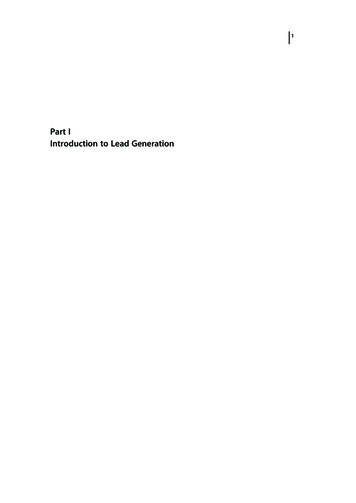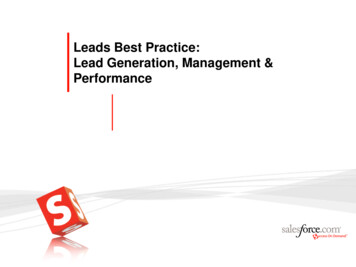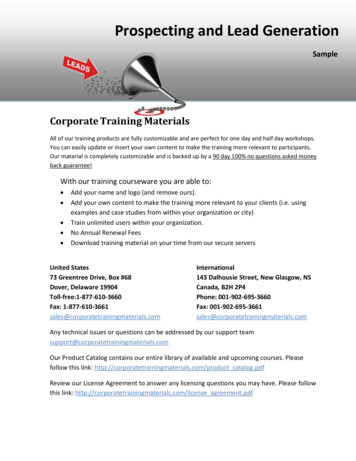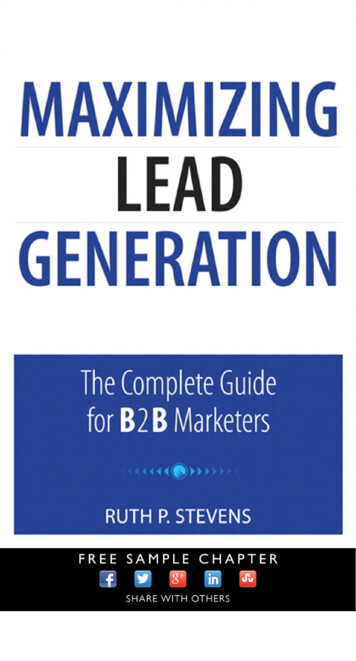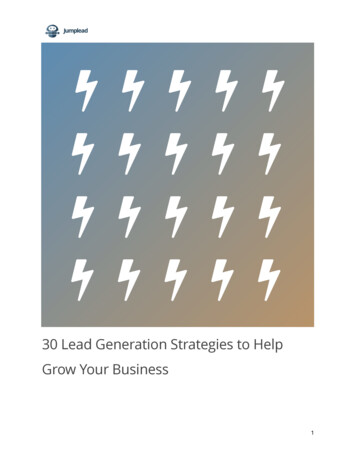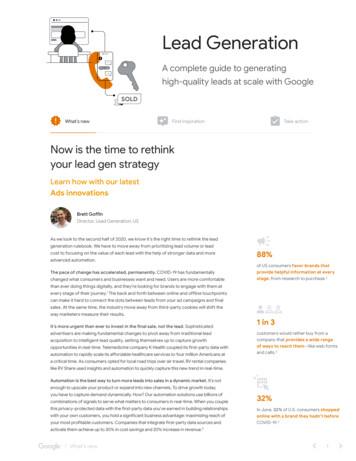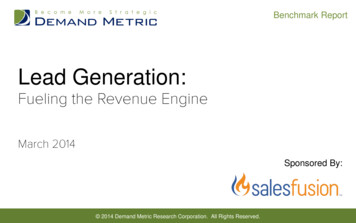
Transcription
Benchmark ReportLead Generation:Sponsored By: 2014 Demand Metric Research Corporation. All Rights Reserved.
TABLE OF CONTENTS3Introduction19Measuring Lead Generation4Executive Summary20Changing the Lead Gen Process6Lead Generation Snapshot25Analyst Bottom Line9Lead Capture & Storage26Acknowledgements11Process Performance27About Salesfusion & Demand Metric17Lead Gen Budget & Cost Per Lead29Appendix – Survey Background
INTRODUCTIONThe marketing funnel – the model that represents how leads become sales – has changed. It’s far more sophisticated than itonce was, with more lead sources, paths through the funnel, and metrics to track it all. While marketers do much more thanjust manage the funnel, when it comes to its relationship with sales, the focus is generally about delivering enoughqualified leads to keep the revenue engine going.Almost every organization has a lead generation process (just 11 percent in this study claimed not to have one), but excellencein lead generation is hard to come by, with just nine percent of this study’s participants reporting that their process is highlyeffective. The process is in the critical path to revenue, accounting for a significant chunk of budget money and marketingresource. The performance of the lead generation process is also quite often the greatest point of friction between thesales and marketing team. For most organizations, there is clearly room for improvement.In a study sponsored by Salesfusion, Demand Metric conducted a survey to explore how marketers are doing lead generation.Answers to these questions were pursued to better understand the current lead generation process: How well is the process working and which lead generation techniques are in use?How are leads captured and where are they stored?How does the process perform in terms of volume and quality of leads?How much budget is allocated to lead generation and what is the estimated cost per lead?How is the effectiveness of the process measured?What process changes would produce the greatest benefit?How will the investment in and emphasis on lead generation change in the next year?These study results provide a report card of sorts, providing benchmark data useful for comparison, planning and improvement.3
EXECUTIVE SUMMARYPrimary research for this study was done using a survey, and the data analysis provides these key findings: Almost all organizations (89 percent) have a lead generation process, and almost half of them rate their process asmoderately to highly effective. The top three approaches to lead generation are email marketing, tradeshow or event marketing, and contentmarketing - this mix remains constant regardless of company size. The most common mechanism (73 percent) for capturing leads is an automated one: a web form. The second mostcommon mechanism (66 percent) is manual: data entry. Regardless of how leads are captured, the most common leadstorage repository is a CRM system. Two key dimensions of lead generation process performance are volume and quality. In this study, 58 percent ofparticipants say their process doesn’t produce enough leads, while 85 percent rate the quality of leads generatedfrom moderate to very high. The existence of a standard or definition for lead quality seems to have a positive influence on quality of leads the processgenerates. For study participants that report their process produces high or very high quality leads, 74 percent had amoderately or very effective lead quality standard in place. Just 48 percent of the full survey sample reported this samelevel of effectiveness for their lead quality standard.4
EXECUTIVE SUMMARY No single metric can adequately indicate the performance of the lead generation process. The most common metric isnumber of leads generated and 59 percent of study participants use three or more metrics to track the effectivenessof their process. The approach to lead generation targeted for the greatest increase in investment is content marketing (70 percent);the approach targeted for the largest decrease is tradeshow or event marketing (40 percent).This report details the results and insights from the analysis of the study data. For more detail on the survey participants, pleasesee the Appendix.5
LEAD GENERATION SNAPSHOTFigure 1: Almost half of respondents report their lead gen process is moderately to highly effective.Lead Generation Process Effectiveness45%This study begins with a “snapshot” of the lead generationprocess.For the companies that are doing lead generation, howeffective is their process and what approaches are in use?40%40%35%Almost 90 percent of companies in this study have a leadgeneration process, and the way they assessed itseffectiveness is depicted in Figure 1.30%25%This assessment is a subjective one, as no criteriawere given to guide participants in rating their processeffectiveness.20%15%15%17%18%10%9%5%0%Very ineffectiveSlightlyineffectiveNeitherineffective oreffectiveModeratelyeffectiveLead Generation Benchmark Report, Demand Metric, March 2014, n 1826Highly effectiveFor most companies, lead generation effectiveness is afunction of both quantity and quality. This study will exploreboth of these dimensions of lead generation effectiveness.
LEAD GENERATION SNAPSHOTFigure 2: Email continues as the “workhorse” of lead generation efforts.An ever-expanding set of channels is in use to generateleads and within each channel there is tremendousvariation in their use. A few approaches to lead generationstill dominate the landscape.Lead Generation Approaches78%Email marketing73%Tradeshow or event marketing57%Social media36%Pay-per-click advertising34%List purchase31%Partnership marketingOther digital advertising26%Other12%0%2%20%40%Lead Generation Benchmark Report, Demand Metric, March 2014, n 1827The top three approaches – email marketing,tradeshow/event marketing, and content marketing –are constant regardless of company size. In fact, theorder of popularity doesn’t change for companies that areexperiencing revenue growth or have flat or decliningrevenue.51%Inside sales/TelemarketingMobile advertisingA goal of this study was to determine which approaches arecurrently in use.67%Content marketing60%80%Likewise, those participants that assess their processeffectiveness as very or slightly ineffective are using thesame approaches as those who are on the opposite end ofthe effectiveness scale.
LEAD GENERATION SNAPSHOTIf everyone is essentially using the same lead generation approaches, why are some having success and others are not?If the approaches are the same, the only variables remaining are frequency and sophistication. The logical conclusion is thatthe issue with effectiveness is not a function of which approach is in use, but how the approach is executed. It’s aquality issue.While not all lead generation is done digitally, much of it is. Data from a recent Demand Metric study on digital marketing,“Digital Marketing Landscape: The Power of Digital Experiences in 2014” demonstrates that the more sophisticated the digitalexperience is, the greater its influence on brand perception. This finding has direct application to lead generation, wheregenerating a favorable brand impression is tantamount to success.8
LEAD CAPTURE & STORAGEFigure 3: Web forms are the top lead capturing mechanism.It is the goal of lead generation to capture a lead forsubsequent nurturing and ideally conversion. Despite lotsof technology that can assist in lead capture, a fair amountof leads are captured using low-tech means. This studyposed a question about lead capture, and the responseoptions for this question were:How Leads are Captured73%Web form66%Data entry60%List import49%Integration21%Social mediaOther0%3%20%40%60%Lead Generation Benchmark Report, Demand Metric, March 2014, n 182980% A web form: Typically this is part of a landing pagewhere a lead is directed through some type of offer. Data entry: Manually entering lead information intowhatever systems are used to store them. List import: Lists acquired from some external source,such as through participation in a trade show. Integration: Direct integration between a lead capturepoint (i.e. landing page) and the systems in which leadsare stored (CRM or marketing automation systems). Social media: Harvesting leads directly from socialmedia posts, comments, likes or follows.Most organizations rely on multiple methods to captureleads – 80 percent of this study’s participants are using atleast two of the methods presented as response optionsand one-third are using three of these methods. As thechannels for lead generation continue to expand, usingmultiple capture methods becomes increasingly important.
LEAD CAPTURE & STORAGEFigure 4: Most leads are stored in CRM systems.Capturing leads is just the first stage in the process ofnurturing and ultimately converting them. Where leads arestored has a lot to do with how consistently the nurturingprocess works.Where Leads are %0%OtherEmailIn-house DBmsgs/foldersMarketing SpreadsheetsAutomationLead Generation Benchmark Report, Demand Metric, March 2014, n 18210CRMA lead is a rather simple collection of information and istherefore storable in relatively unsophisticated systems,including hardcopy. The problem, when leads are stored inplaces or systems not specifically designed for managingleads, is that they aren’t uniformly nurtured. It’s too easyfor leads to “fall through the cracks” when they’re stored inspreadsheets or email folders.CRM and marketing automation systems are designed tohouse leads and they provide tools and automation to makesure that leads make it to the sales team. Furthermore,these systems are designed to track and report on thestatus of leads stored within them.Participants in this study that report using CRM ormarketing automation systems as the primaryrepository for leads rate their lead generation processas moderately or highly effective 59 percent of thetime, compared to 49 percent for the full surveysample.
PROCESS PERFORMANCE – VOLUME & QUALITYFigure 5: Over half the organizations in this study report their lead generation process does notproduce enough leads.Lead Generation Volume40%35%30%20%The sales team usually has an insatiable appetite for leadsand when the generation process doesn’t produce enoughof them, it risks idling the sales team and negativelyimpacting revenue.34%It’s tempting to dismiss these lead volume results as justthe constant refrain from the sales team demanding moreleads.23%10%7%1%0%Far fewerFewerAdequateMoreLead Generation Benchmark Report, Demand Metric, March 2014, n 18211Most lead generation processes are judged across twodimensions – volume and quality.Far moreTwo-thirds of the study participants, however, werefrom the ranks of marketing, over half of which areessentially admitting that their process doesn’tproduce enough leads.
PROCESS PERFORMANCE – VOLUME & QUALITYShould other processes come into play when talking about lead volume as well?Of course, such as customer retention: keeping the customers you already have offsets the need to acquire new ones.There is also simply the effectiveness of the lead nurturing process:Is marketing required to generate leads of such high quality that little in the way of sales effort is needed to convert them?Lead generation volume is not a metric to consider in isolation, just generating more leads is not the cure to all the ills of thesales process. In fact, an overemphasis on quantity can enable or disguise critical process flaws in other areas. However, theprocess must generate an adequate number of leads and more participants in this study say it does not than does.The other side of this lead generation process performance coin is quality. When evaluating the performance of the leadgeneration process, it’s necessary to consider both quantity and quality.Conventional wisdom says that a sales team can live with lower lead volumes if the quality of leads generated is highand the reverse is also true, low lead quality is offset by higher lead volume. Figure 6 (on the next page) summarizes thelead quality data from this study.12
PROCESS PERFORMANCE – VOLUME & QUALITYFigure 6: 85% of participants rate lead quality as moderate to very high.In any process, there is room for improvement and thatneed was apparent when considering the volume of leadsgenerated by most organizations in this study.Lead Generation Quality70%60%Here too, when considering quality, there is room forimprovement, but much less so, with 85 percent oforganizations in this study reporting lead quality asmoderate to very high. Conceptually, it is ideal if leadquality is at the highest possible level, but realistically, thereis a point of diminishing returns when too much is beinginvested to get it there. If the supporting processes areworking as they should – lead nurturing in particular – theneed to consistently produce high quality leads is lessimportant.63%50%40%30%20%21%10%2%13%1%0%Very poorPoorModerateHighLead Generation Benchmark Report, Demand Metric, March 2014, n 18213Very highModerate quality is probably really what an effectivelead generation process should produce, assuming thesurrounding supporting processes are in place andworking well. If an organization has the proper systems inplace, primarily CRM and marketing automation, it doesn’tneed to overinvest in producing consistently high qualityleads at the expense of related and equally importantprocesses.
PROCESS PERFORMANCE – VOLUME & QUALITYFigure 7: Over one-fourth of study participants have no lead quality standard or definition.Existence of Lead Quality Definition or Standard40%38%Organizations that are more mature in their lead generationprocesses and efforts have lead quality definitions in place,often formalized through agreements between marketingand sales.30%26%26%20%10%Having a standard or definition in place for lead qua
Lead Generation Benchmark Report, Demand Metric, March 2014, n 182 10 Figure 4: Most leads are stored in CRM systems. 23% 35% 34% 7% 1% 0% 10% 20% 30% 40% Far fewer Fewer Adequate More Far more Lead Generation Volume PROCESS PERFORMANCE – VOLUME & QUALITY Most lead generation processes are judged across two dimensions – volume and quality. The sales team
